#tobor is robot spelled backwards
Explore tagged Tumblr posts
Text
It has been twelve years since I last saw Sharkboy and Lavagirl and I realized today that "Tobor" is just ROBOT spelled BACKWARDS
4 notes
·
View notes
Photo

Devil Girl from Mars
This movie qualifies itself for MST3K by the robot alone. I don't think anybody involved with it ever made it to the Satellite of Love– in fact, most of the cast had made real movies in the past and went on to make more of them. But Devil Girl from Mars has a dumb title and a terrible robot, and anybody who’s seen it will agree that’s all it needs.
It's a dark and stormy night somewhere in Scotland when Robert, an escaped convict, shows up at the isolated pub where his ex-girlfriend Doris works, hoping she'll help him hide from the police. She agrees, though it's obviously going to make both their lives far more complicated... but not as complicated as the arrival of Naya, a Martian who lands her flying saucer just metres from the front door. It seems Mars had a war between the sexes, which ended in the near-extermination of the men. That's right, it's another movie about aliens coming to Earth looking for breeding stock. Can one jailbird and the staff and guests at a Scottish pub possibly stop Naya in time?
Someday when humans have left the Earth behind and set out to see the galaxy, I rather suspect it'll be us visiting random planets and saying things like, “hey, we're all out of males, can we borrow some of yours?” And it won't be because we've actually had some kind of reproductive crisis, it'll be because we're bored and horny and we want to fuck some aliens.
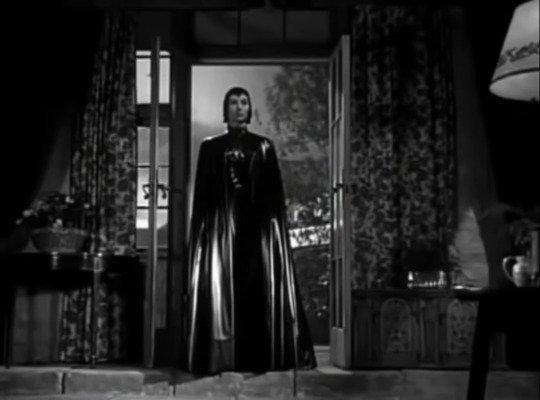
I guess I'm going to start with the things I like about this movie. It's a short list. Naya explains that the reason she was forced to land so far from her destination of London is because Earth's atmosphere was denser than she'd expected. This kinda makes sense – the atmosphere of Mars is extremely thin and creatures adapted to that might have a hard time believing life forms could survive in air as thick as ours. It's about the only nod to actual science that the script ever makes, so that's nice.
The other thing I like is how the movie treats Naya. The 'we've run out of potential mating partners' trope, as manifest in things like Fire Maidens of Outer Space and Cat-Women of the Moon, is usually an excuse to have a hot alien babe fall in love with a thoroughly dull and unremarkable Earth man. Devil Girl from Mars never even considers this idea. Naya is always and only ever a threat. The humans are nothing to her but specimens, and none of them ever even mention the idea that she could be considered physically attractive. Actress Patricia Laffan, in platform shoes that make her as tall as any of the men, never portrays her as even unintentionally sultry or sexy, only as cruel, arrogant, and increasingly fed up with these insects who believe they can oppose her. The only person who considers Naya a sex object is the costume designer, who was definitely jerking off when he came up with that Sexy Darth Vader getup she wears.
Other aspects of Naya's behaviour, unfortunately, are terribly inconsistent, particularly her technology. She demonstrates early on that she can hypnotize and control humans to do whatever she wants – so why doesn't she just force the men to come with her while leaving the women behind, instead of letting them wander around and plot against her? In another scene, she vaporizes a guy leaving nothing behind but his glasses. There's no reason why Naya as presented to us wouldn't do the same to any human she deems less than useful. We wouldn't have a story if she just did the most efficient thing, of course, but the movie never even tries to come up with an excuse. I think the writer just hoped we wouldn't notice.
Then there's the robot. It looks like a fridge on legs, and is a step up from the robot that fought the Aztec Mummy only because it has an approximation of knees. It appears in a single scene, clumping around at somewhat less than human walking speed and vaporizing a couple of things before thumping back into the spaceship never to be seen again. Enough time is spent on this and the impression it makes on the human characters that it seems like it ought to be setting up for the robot to do something really cool at the climax... but it doesn't. It's only there to have a space robot in the movie.

The robot is truly hilarious. It's supposed to be this huge threatening hulk but the only thing I would be afraid of is that it might topple over on me. My Mom remembers seeing this movie as a kid and told me even then she wondered why they didn't just push the robot over. With its noodly tube arms there's no way it'd be able to get up again. Sadly, the robot is a good eighty-five percent of all the actual entertainment value this film has to offer.
Devil Girl from Mars is based on a stage play, and you can kind of tell – almost everything that happens does so in a single room in the pub, with only brief (and sometimes dialogue-less) excursions to Naya's flying saucer and a couple of other rooms in the building. Furthermore, very little of it counts as 'action'. Most of the movie is just people talking to each other and drinking. I can tell what the script is going for. We're meant to feel a sense of claustrophobia, of being trapped and impotent while the world falls to pieces all around us (an annoyingly relatable situation, really). Unfortunately, it never quite gets there. Rather than biting our nails wondering what will happen next, the audience just wishes the movie would get on with things. A couple of times the characters come up with a plan to kill or capture Naya but these never accomplish anything but annoying her further.
The odd side-effect of this is that the character who is easiest to empathize with is actually Naya herself. She's stuck here until her spaceship is repaired, so she's killing time and getting irritated with these people who are not what she came to see. That's us! We're stuck watching this movie that we hoped would have cool space stuff in it, but it doesn't, and now we're just waiting for it to be over!
I guess the characters are supposed to have arcs. The major one is the little love story between Ellen, a guest at the pub, and Mike, the reporter here to cover the odd events unfolding in the area. She has been unlucky in love and has come to this remote place to hide from the world, not wanting to let herself get close to anybody for fear of being hurt again. He went through hell in World War II and now finds solace in alcohol and being an asshole. Supposedly the situation strips both of them of their pretensions and lets them see each other's vulnerabilities, but we never really feel that. The entire thing is talked at us rather than shown.
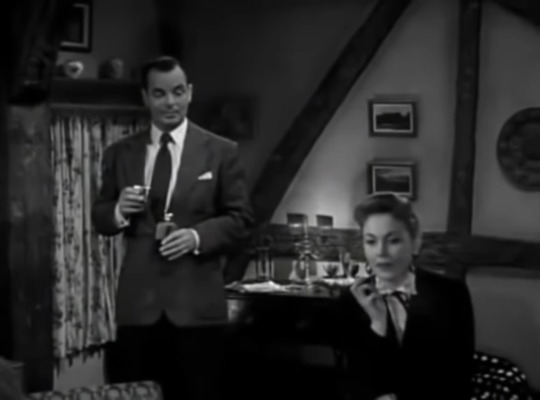
Then there's Robert and Doris, who are introduced as if they ought to be the main characters. Unsurprisingly at this point, they're barely in the rest of the movie. Their situation, with Doris wanting to help but knowing she shouldn't, and Robert on the run but with no long-term plan yet, is very much the most interesting thing going on here, even more so than the whole 'Mars needs Men' a-plot. I kind of want to see a movie just about the two of them trying to figure out where to go from here. As it is, their story isn't so much part of the plot as it is interrupted by it, and the ending doesn't solve their problems but merely renders them irrelevant.
Other characters are fairly useless. The Professor (of course there's a Professor in a movie like this) is only here to say sciency shit and explain to the rest of the cast how to destroy Naya's spaceship. The Cute Kid (also an inevitability) is here to gush about how cool the spaceship is and so that Naya can take him hostage. And the old couple who run the pub are our collective nemeses, the comic relief characters who are never actually funny. The joke is that Mr. Jamieson would be an alcoholic if only his wife would let him drink. Mrs. Jamieson putters around clucking over everybody and telling them to put their trust in the Lord, which has always struck me as an odd reaction to an alien invasion.

I think the biggest reason why Devil Girl from Mars feels so unsatisfying is because we never get the idea that this story means anything. The specific reason why Naya has come to Earth is basically irrelevant to the events that unfold – it only matters that she's there and must be gotten rid of, or more Martians will follow her. She could have come to Earth for specimens, for water, for gold, or for Professor Maki's super-advanced rocket fuel and this story would have happened the same way. The 'war of the sexes' is referenced and then dropped.
I dragged a bunch of other 'aliens need mates' movies at the beginning of this review but they all at least tried to do something with the concept. Generally such movies advance the idea that neither men nor women can exist without the love of the other. This is an unpleasantly parochial statement, but at least it's a statement. Devil Girl from Mars doesn't seem to have a statement. Maybe Robert redeems himself, since he's a convict on the run and all... but he doesn't seem to need redemption, since he insists the death of his wife was an accident, not a murder. Perhaps he is redeemed in the eyes of those who believed he was a murderer, but we don't see that, since the movie ends pretty much right away after the spaceship blows up. There is no reward for sitting through all this.
#mst3k#reviews#episodes that never were#devil girl from mars#50's#we're running out of plots#tobor is robot spelled backwards
42 notes
·
View notes
Text
WARNING: Before You Watch Zack Snyder’s JUSTICE LEAGUE
As you may have heard, Zack Snyder’s Justice League is being presented in a 4:3 aspect ratio in order to preserve the visionary director’s directorial vision. It is also being offered in black-and-white, the director’s preferred color palette. Also, Willem Dafoe’s scenes as Aquaman character Vulko have been restored, and new footage has been shot to spotlight Robert Pattinson of The Batman, who is rumored to have a romantic encounter with Lori Lemaris.
However, you may not be aware of these additional requirements in order to experience Zack Snyder’s JUSTICE LEAGUE in its intended format:
Zack Snyder’s JUSTICE LEAGUE requires Netscape 2.01 or later.
Zack Snyder’s JUSTICE LEAGUE is presented in “pan-and-scan” format. The characters talking from just out of frame are normal.
Zack Snyder’s JUSTICE LEAGUE is best viewed at 640x480 resolution.
Zack Snyder’s JUSTICE LEAGUE: The Soundtrack is available now on UMD.
Zack Snyder’s JUSTICE LEAGUE is brought to you by Mentos: The Freshmaker!
Zack Snyder’s JUSTICE LEAGUE is Under Construction.

Zack Snyder’s JUSTICE LEAGUE is part of the SnyderCut Webring.
[Prev 5] [Prev] [Next] [Random] [Next 5] [List]
Zack Snyder’s JUSTICE LEAGUE is presented with limited commercial interruptions. Tobor is Robot spelled backwards.
Zack Snyder’s JUSTICE LEAGUE may contain Olestra.
Zack Snyder’s JUSTICE LEAGUE will only stream via RealPlayer.
#please sign the Zack Snyder's JUSTICE LEAGUE guestbook#Zack Snyder's JUSTICE LEAGUE#Justice League#satire#the lighthouse#dc comics
8 notes
·
View notes
Photo

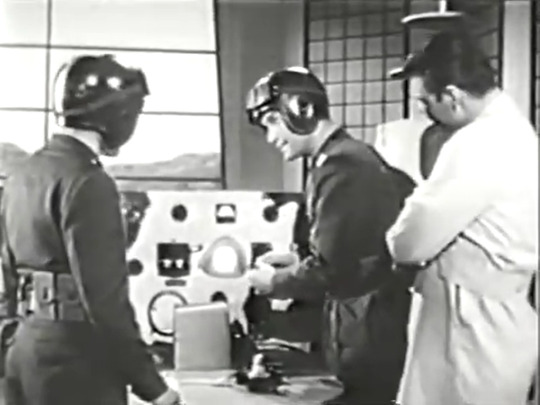
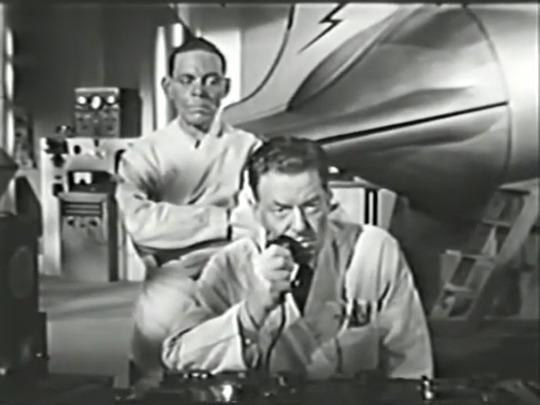
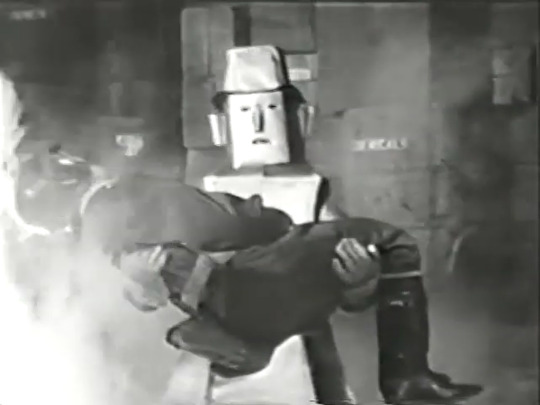
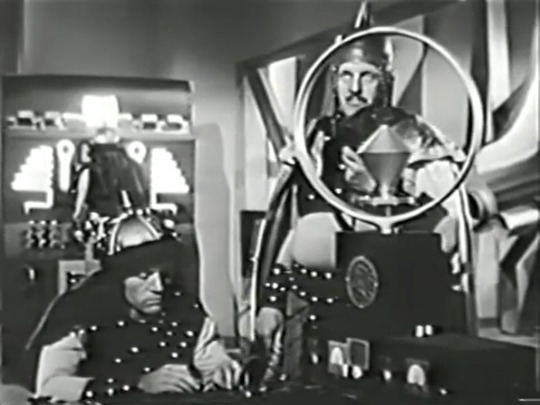
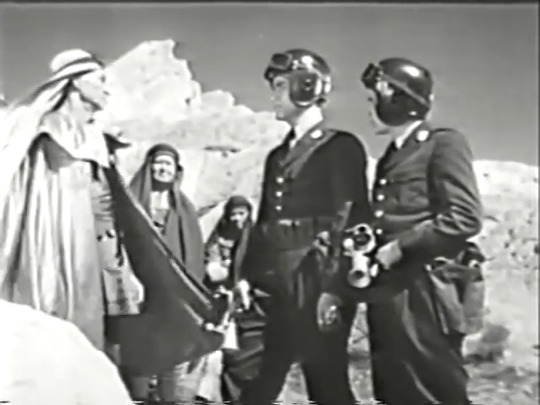
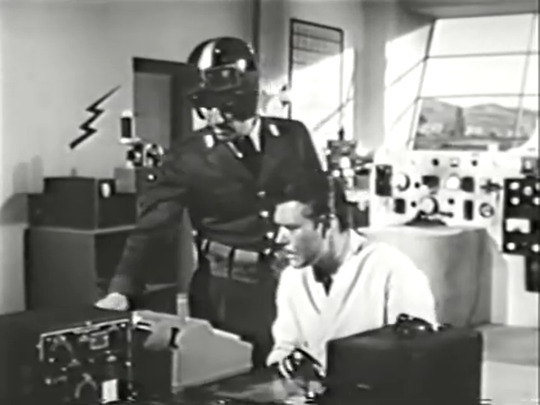

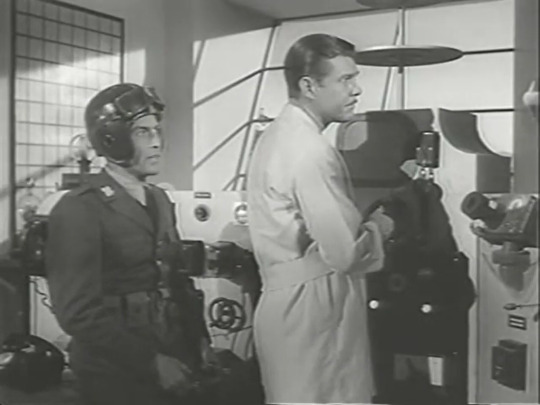
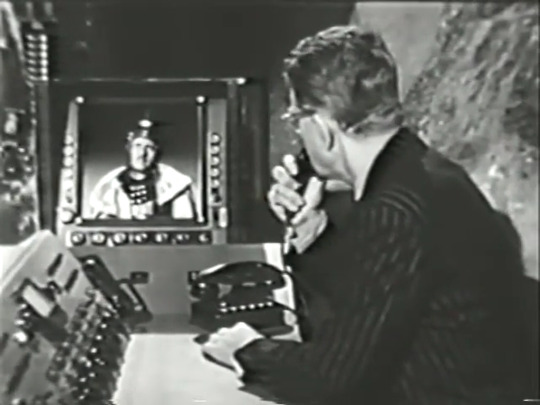
Captain Video: Master of the Stratosphere (1951)
Film review #379
SYNOPSIS: The heroic Captain Video and his Video Rangers from across the globe help maintain peace on the planet Earth, but when Earth becomes subject to meteor bombardments from the planet Atoma, Captain Video must find a way to thwart the evil schemes of it’s leader Vultura before it is too late...
THOUGHTS/ANALYSIS: Captain Video: Master of the Stratosphere is a 1951 movie serial. The serial stars (as the title suggests) Captain Video, the leader of an organisation called the Video Rangers, who help protect the Earth. When the Earth becomes subject to meteor bombardments originating from the planet Atoma, Video must stop them before they can invade the Earth. The plot resembles the vast majority of sci-fi serials, which copy the highly successful Flash Gordon and caught the genre in a thinly-veiled repetition of its plot and characters for over twenty years. A lot of the story revolves around Captain Video trying to prove that the scientist Dr. Tobor (yes, that is ‘robot’ spelled backwards) is working with Atoma’s leader Vultura, as Video and Vultura try to outsmart and thwart the other’s plans. I think this format and plot structures were gotten away with for two reasons: one, there was no way to re-watch old serials once they had first aired at the theatre, so new ones could come out with the same story and similar characters; particularly since serials such as this would be aimed at kids, who would not have seen earlier serials. The second reason being that the second world war probably didn’t leave much room or money for the development of anything too original or ambitious, as resources would have been focused elsewhere. Nevertheless, by the time this serial was released in 1951, there probably should have been some effort to change the formula or offer something new.
Despite it’s lack of originality in the story department, there’s still a decent amount of variety going on. The early chapters see Video travelling to the planet Theros, where the peace-loving people are under attack by Vultura’s forces, and Video has to teach them to be guerrilla fighters and fight back. Again, this plot structure shows up in many previous serials. The next major chunk of the serial consists in the back-and-forth between Tobor and Video, as they try and outdo each other on Earth. Video and Vultura only meet in the final half of the last chapter, which feels like a waste. The serial however, does keep things interesting with a whole host of gadgets and inventions that would undoubtedly spark the imaginations of youngsters watching. The guns that the Rangers use that shoot out sparks are quite a nice effect of the time. However, the serial often falls into the trap of explaining what is going on and what all these inventions do rather than actually showing them, mostly due to budget constraints, but often the plot is explained before it happens, leaving little surprise or tension. The inventions too have bizarre technological names, and accompanied techno-babble that try to justify the implausible things they do.
Most of the characters are based off the ones on the TV series, with Captain Video being the typical white American male hero that is the star of all these serials. His younger sidekick is strangely only referred to as “the Ranger” and never given an actual name. This is in keeping with the TV series, but other rangers are shown to use their own names, so it’s odd that he doesn’t. Maybe it’s a way to get kids to imagine themselves in the role of the young teenage sidekick, as anyone could be “The Ranger”. There’s also Ranger Gallagher, who does all the technical stuff at Video headquarters, and Vultura clearly has some east Asian influences in his design, again echoing the “Ming the Merciless” type villain that originated in Flash Gordon. One final note about the characters is that while you will expect these serials to only feature a white cast, there is not a single woman anywhere featured in the serials fifteen chapters. Often there is usually a solitary token female character that sometimes serves as the protagonist’s love interest, but there is none at all here, not even in any of the backgrounds. I suppose the lack of a female character could be attributed to the fact this is geared towards a younger, male, audience, who would not be interested in a female character or a romance sub-plot, but having this cast of inter-changeable white men interact with each other really emphasises the monotony of the story at points.
The serial was directed by Spencer Bennet, a veteran of these kinds of serials, so he had plenty of experience in what to do. Some of the effects are fairly decent; as mentioned, the ray guns the Video Rangers use is pretty cool, and their super-fast car stands out with its unique look. There is also a ‘space platform’ which allows transportation between earth and Atoma, which apparently is millions of miles away. Captain Video also has a rocket ship he travels in, which again adds some variety. Some of the effects (such as the rocket ship in flight) are done through using hand-drawn animation, which allows a lot more freedom in terms of effects, although this is not the first time this was done, having been integrated into the Superman serial a few years earlier. Overall, I think I can place the Captain Video serial just above average in the miasma of similar sci-fi serials: it has a lot of the well-worn tropes and characters, but has some decent effects and various inventions that add a bit of extra spice. It’s obviously meant for a younger audience, but there’s enough content for those who haven’t seen such a serial before to enjoy.
#movie#movie review#captain video: master of the stratosphere#captain video#sci-fi#movie serial#serial#film#film review#1951 film
5 notes
·
View notes
Text
“TOBOR is ROBOT spelled backwards!”
Advertising circa 1978, folks.
2 notes
·
View notes
Text
Tobor is robot spelled backwards! Old toy by Schaper

14 notes
·
View notes
Note
so is Tobor's name being Robot backwards supposed to mean anything
Uhh... he got his identity stolen by a guy who likes technology? I dunno. The wiki says “Unlike most Guardians, Tobor is not named for anyone or anything famous. Instead, his name is robot spelled backwards.”
30 notes
·
View notes
Text
May 4: Sakurai’s Love of Star Wars
I was initially going to put this on a later date, merely to thumb my nose with as much pretentiousness as possible at “May 4th be with you,” but eh; not sure what else to talk about tonight. Basically, Masahiro Sakurai really loves Star Wars; references to the original trilogy (and the prequels, albeit to a somewhat lesser extent) are everywhere throughout Kirby, Super Smash Bros., and Kid Icarus: Uprising.
youtube
And honestly? It’s really nice. I’ve had kind of a weird relationship with Star Wars (liking it, then obsessing over it, then coming back to it in a more muted way, and then...look, I really loved The Last Jedi, okay?) and find it just a bit overbearing in too large or frequent of doses, but there is a genuine magic Lucas and his sadly forgotten team tapped in that first movie. All that stuff about making it the perfect “hero’s journey” is honestly kinda hooey - he and Joseph Campbell kind of used each other, like how some bacteria in my organs help digest food and keep my body functioning - but there is something there. Lucas threw everything he loved in a pot, from Kurosawa to westerns to WWII movies to serials to Planet of the Apes to 1950s car culture,* and something special came out.
* Anyone wants me to talk about how each source is used, I’m down to talk about it.
And I’m not sure how cognizant Sakurai necessarily is of that history (though he probably should be, right? I mean, Meteos was inspired by 24 of all things - Uprising probably was, too, given its plotting - and it’s kind of weird thinking of that of all shows being shown in another country), but it certainly fits his own work history. Like, Kirby was a platform game, but it was one with a whole new time of level design and vision, and he filled it with all sorts of things he personally liked, like spicy curry that makes you powerful. And of course, Smash is, well, Smash; he fills it with all sorts of things he likes and things that just seem interesting.
That’s an approach to creating art that’s very risky; a good result becomes something wholly it’s own, while bad ones can be found a dime a dozen on most conventional Archive of Our Own crossover collections. But it’s also something that can be really incredible. It can work for long-form storytelling, with a show like, say, The X-Files throwing all sorts of things in a pot and coming out with something lovely. And it especially worked for Smash, and Sakurai’s other projects. Uprising especially does that well: it took in Star Wars (and like I posited earlier, probably 24), but also manga and anime, and the Greek mythology of the original game, and Star Fox, and honestly some of the early levels give me a “God of War but actually pleasant” sensation. Certainly the first battle with Twinbellows.
All this is to say that one of the most immediately compelling and enticing things to do when creating something is to take two things you like and shove them together. And a lot of time, what you end up with is derivative; if you’re lucky it’ll be at least iterative or having some ideas of its own. But if you get it right, if all the things work so well it’s easy to miss them, then I guess you’re an alchemist, then.
Oh, right. Need a Star Wars reference. Hey, everyone! Let’s go get Tobor! Remember, Tobor is “Robot” spelled backwards.”
youtube
♫ “...Vote for...the union label...” ♫
(Link to my writings on Smash Bros for Nintendo Switch)
4 notes
·
View notes
Photo

Sonicman
Even if this one hadn't been a Rifftrack under the title Supersonic Man, it still stars Cameron Mitchell (Commander Santa Claus from Space Mutiny) and was directed by Juan P. Simon (the auteur behind Pod People), and it's still a stupid superhero rip-off at least as silly as Pumaman and even more shoddily-made. Vehicles were provided by Toys R Us, and there's a ridiculous robot that, sure enough, doesn't even have knees.
Some aliens somewhere have noticed humanity playing with our radioactive toys, and decided to do something about that before we blow ourselves to bits and take the rest of the galaxy with us. To this end they send us Supersonic, a blue-skinned luchador in a sparkly costume. In his earthly disguise as private detective Paul, the hero starts looking into the disappearance of Professor Morgan, a scientist who has been kidnapped by the evil Dr. Gulik as part of an extremely vague World Domination scheme. Since the Professor is not cooperating, Gulik decides to also kidnap his daughter Patricia, and Paul steps up to protect her, too. Can they stop Gulik before he blasts off into space and sets his plan, whatever it is, into motion?
This movie is very obviously targeted at people who saw the Christopher Reeves Superman movie the year before and wanted more of that. In the fine tradition of blockbuster ripoffs, it does not remotely count as 'more of that' because the film-makers copied everything about that except for the fact that that was a good movie.

There is certainly a lot of superhero stuff that goes on. Supersonic can fly and bullets bounce off him, and he also appears to have assorted telekinetic powers that include turning guns into bananas. The bad guys have lots of villain crap like secret islands and a very slow but very shiny tin robot with a flamethrower. The hero even has the requisite super-weakness – he needs his smartwatch screensaver to transform into Supersonic and if he can't reach it, he's stuck in human form as Paul, who looks like a younger and less funny Ron Swanson and is pretty much constantly getting his ass kicked. This successfully adds drama to the proceedings on more than one occasion, which rather surprised me.
Thing is, Superman is not just an invincible flying dude. Superman is a character, and so is his supporting cast, like Lois Lane and Lex Luthor. They have relationships and reasons why they do the things they do. Sonicman just skips over all of that.
Superman knows how to get around on Earth because he was raised here, and he became a superhero because of a deep conviction that he's here for a reason and parents who taught him to be humble and do the right thing. His civilian identity as a reporter is part of this – he uncovers the truth and brings it to the common people.
Supersonic is just dropped on Earth with a job to do, and the Emerald Men or whoever his overlords are have downloaded all the information he'll need into his brain. This could be a perfectly good beginning for a movie about a superhero from outer space – he knows in theory how humans interact and how to blend in, and now he has to apply that. There is scope for comedy and interest here but it is never used because the writers don't care about Supersonic as a character, they just want to put him in situations where he can do super stuff. We can never be said to 'meet' Paul. He does not have a single definable personality trait. At the end he's supposed to have fallen in love with the planet Earth and particularly with Patricia Morgan, and we have no idea why.

Patricia, similarly, has nothing to her. She's just a pretty face wandering around. There's no sign of her having a job. We understand what Superman sees in Lois Lane – she was a reporter back when that meant exposing Watergate rather than telling us which Kardashians had which surgery this week, and is generally portrayed as somebody of great courage and integrity. She represents what Superman aspires to be in the role of Clark Kent, they have common goals and interests, and they make a good team both personally and professionally. Paul and Patricia seem to be in love just because they're the main characters of the movie and that's what they're supposed to do.
Professor Morgan is even more of a cipher. All he does is hang around in Dr. Gulik's evil lair and impotently protest that good will always overcome evil.
Dr. Gulik himself probably has more dialogue than the rest of the main characters put together, but none of it makes sense. He rants on about ultimate power and ruling the world, about death rays and nukes and so forth. He yells at his minions for disappointing him and calls up the heroes to gloat a couple of times, but as for who he is, what he wants, or why he's like this, we never have a clue. At the end he blasts off in a spaceship which he apparently just had sitting around (now we know how Bezos is planning to escape when the Amazon workers unionize), and Supersonic blows him up. This is not particularly interesting. The whole movie could have been made by waving action figures in front of the camera and it would probably be more enjoyable.
There is one more major character... and he is here for absolutely no reason other than to make the movie even worse. This is the Funny Drunk who hangs around in front of Patricia's house. He's wearing a sandwich board which states in several languages that he's collecting donations to help alcoholics, and the punch line is that he's obviously just going to spend the money on booze. This is gross and the fact that it's supposed to be a joke makes it grosser. The drunk's presence also makes other characters do things that aren't funny. When Paul discovers that drunk dude has guzzled the champagne he brought to share with Patricia, he turns into Supersonic and flies to a classy restaurant, where he walks in, takes a bottle of champagne out of a bucket, and walks out again. This is presented as if it's supposed to be funny but it's... it's just Supersonic using his invincibility to steal shit.

The chef at the restaurant is an Italian stereotype. I was going to say that I guess I can't complain about that in an Italian movie, but then I remembered that this movie is actually Spanish. Now I don't know what to think. Do Spain and Italy not like each other? I thought they were okay because they were both Catholic.
I kind of wonder what actors think about when playing characters like this. Do they get backstory and personality notes from the writer and directors and that doesn't come across to the audience because nobody here is competent? Or are they just handed a script and told to say their lines, and do so without bothering to get deeper into it? Maybe they figure for a cash-in like this it's not really worth the effort.
About the only thing left to watch this movie for is the wildly under-budget special effects, which are occasionally amusing. The tagline for Superman was you will believe a man can fly, and they took a lot of care to make everything look as real as it possibly could. Sonicman did not have the money to do likewise. What they could afford included toy boats and helicopters, a plywood steamroller that is funnier in its five seconds of screen time than the drunk guy could dream of being, and of course the ridiculous robot. The latter is clearly the most expensive thing in the movie and they're very, very proud of it – which makes it all the more hilarious that the robot moves slower than the Creeping Terror and never really does anything important.

It would be absolutely meaningless to talk about this movie's point. The only goal the people behind Sonicman had in mind was to earn some money by tossing their kazoo on the Superman bandwagon. The idea that their story could mean something probably never entered their heads. 'Love conquers all' might be a thing in it, since Paul throws away his smartwatch and gives up his powers in order to stay on Earth with Patricia... but we haven't been given any reason to be interested in that. Paul has never seemed to really like or dislike Earth and its people, so this choice is merely a cliché, not anything meaningful.
Superhero movies are often about power and how we use it, who should be allowed to wield it and for what purpose. Sonicman kind of tries to be about this, what with Dr. Gulik going on about power and Professor Morgan playing Achronus to his Zor. But as I've already said, these conversations make absolutely no sense, and Supersonic isn't really interested in his own power and what it means. Power is something Superman struggles with a little, as he promises never to travel faster than light but then breaks it in order to save Lois' life, or in the sequel when he tries to give up his powers in order to live a normal life with her but finds he has responsibilities greater than that. Even the thoroughly reviled Superman IV: the Quest for Peace did something with this, as he decides he does not have the right to force humanity into peaceful coexistence. Sonicman cannot explore ideas like this, because it cannot be bothered to give its characters and conflicts enough depth for it.
When you just describe it, Sonicman sounds like it ought to be a fun bad movie, but the complete lack of any character to its characters leaves it merely bland. It's never funny on purpose and doesn't manage to be funny by accident nearly often enough to make it worth watching. No matter what you were expecting of it, it'll disappoint you.
#mst3k#reviews#episodes that never were#sonicman#tobor is robot spelled backwards#70s#supersonic man
16 notes
·
View notes
Photo
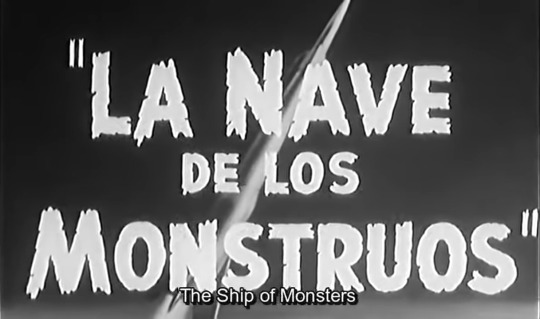
The Ship of Monsters
Check me out, I’m being topical! I had another review almost finished for today, but when I saw the news I knew I had to set that aside and find a movie about life on Venus. This one is a ridiculous Mexican film starring Lorena Velazquez from Samson vs the Vampire Women (looking only slightly less like Cher) and one of those amazing cardboard robots you only get in the very worst of late 50’s and early 60’s sci-fi.
An atomic war on the planet Venus has killed off all the males, so an expedition is sent out in search of replacements, consisting of a native Venusian named Gamma, her Uranian navigator Beta, and their robot Tor. After promising the Empress that they will bring back only the most manly of men, they wander the solar system a while collecting creatures with penises before an engine problem forces them to land on Earth. The first human they meet there is Laureano Gomez, a singing cowboy with a well-earned reputation for telling tall tales. One might assume one could predict the rest of the movie from there… but then Beta turns on Gamma and reveals that her true mission all along was to conquer a planet to feed the vampires of Uranus!
I gotta say… I did not see that coming.

The Ship of Monsters is supposed to be a comedy. It’s seldom funny when it’s trying to be, although it mercifully avoids being the kind of desperately unfunny a lot of bad comedies are… possibly this is because it’s in Spanish, and by the time I’ve realized something is stupid there’s another subtitle to distract me. The jokes, such as they are, are pretty standard. Tor the robot was created by an alien race, who were aware of Earth but never bothered exploring it because they thought the inhabitants weren’t very intelligent. Laureano is in the habit of telling ridiculous stories to his drinking buddies, so of course when he claims the Earth is being invaded by space monsters they don’t believe him. That sort of thing. The movie is much funnier when it’s just showing us absurd situations, but to nobody’s surprise, The Ship of Monsters is at its funniest when it’s trying to be serious.
This hilarity comes in many forms, covering just about all the possible bases for a dirt-cheap 1960 sci-fi film. We have spaceship sets made of cardboard, covered with buttons that don’t actually press and levers conveniently placed so people can bump into them during fight scenes. We have Tor, with his tin can body that’s always a little dinged up but never in the same places, giving us clues as to what order the scenes might have been shot in. He also has wiggly spring antennae and makes a little whirring noise every time he moves. We have space babes in silver bathing suits and glittery high heels. Vampire-Beta, sporting plastic fangs that look like they came from the bottom of a cereal box, could be the female counterpart to the guy from Dracula vs Frankenstein, and the puppet used to represent her in flight is nearly as bad as the one from The Devil Bat.
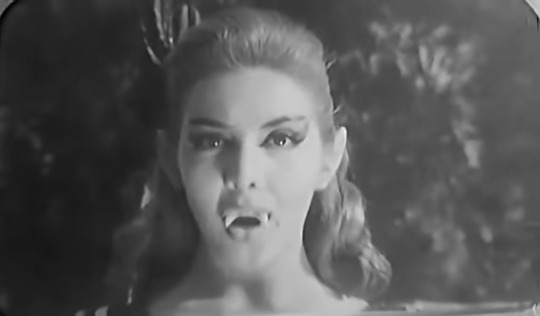
The ‘monsters’ of the title are a bulging-brained Martian prince, a scaly cyclops, a spidery creature with venomous fangs, and the mobile skeleton of what appears to be a *damn worwelf (he tells us that his race has Evolved Beyond Flesh... apparently not Beyond Bones, though). The costumes are all terrible, particularly the warwulf puppet, whose backbone extends into his mouth and who has to be carried around with his feet dangling in any shot that’s not a close-up. It’s nice, though, that a little imagination went into them, and somebody gave a bit of thought to the idea that a monstrous appearance is relative. The Martian tells Beta that he admires her ambition and might even marry her if she weren’t so ugly by his planet’s standards.
At the end, naturally, this alien invasion is defeated by Laureano, his twelve-year-old brother, and a cardboard robot, while Gamma just stands around and screams. With a movie like this I expect nothing less. The denouement contains my favourite intentional joke in the whole thing, in which Gamma stays on Earth with her True Love, and Tor the robot takes his, the Jukebox, back to Venus with him! Tom Servo would have given a speech to congratulate the happy couple, and I can just see him breaking down into happy tears before he got five lines in.
(The wirwalf skeleton is not present at the climactic fight, by the way… no explanation is offered, and I strongly suspect that they broke the puppet trying. I rather enjoy this omission, because it lets me imagine him getting lost or maybe buried by an enterprising dog, and finally finding his way back to the landing site only to learn that they’ve left without him.)
I called Laureano a cowboy but he only has one cow. Her name is Lolobrijida and she is the very first time I have ever seen a movie spur a hero into action by killing his cow. She gets a proper Teenagers from Outer Space death, with her skeleton left behind propped up by metal struts like a dinosaur in a museum!
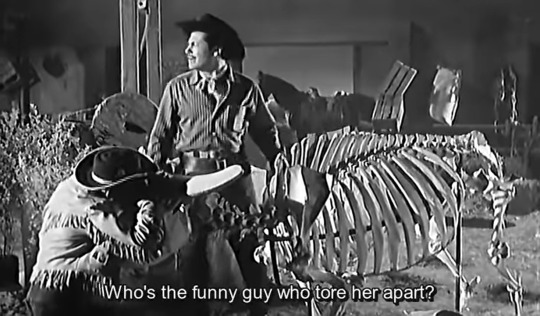
I also called him a singing cowboy, which he is – there are several songs, including one in which he tries to explain to Gamma and Beta what ‘love’ means. The songs have pleasant but forgettable Mexican pop melodies, and none of the lyrics make a whole lot of sense. Being translated over-literally from Spanish probably didn’t do them any favours (my own Spanish tops out at yo no tengo dinero), but I still can’t imagine that the What Is Love song clarified anything.
Laureano himself comes across as kind of a fool, but he’s not actually a full-on idiot, which is quite important. If he were the kind of one-dimensional ‘comedic nitwit’ embodied in characters like Dropo, or the janitor from Reptilicus, he’d be insufferable. Laureano is no genius, but he’s got personality traits besides being stupid – he cares deeply for his little brother Chuy and for his animals, and he doesn’t treat Gamma and Beta’s appearance as two women for the price of one. Very quickly he decides that Gamma is the one he loves, and he sticks to that, doing his best to let Beta down gently even when she offers to make him a king. He’s also smart enough to trick Beta into dancing with him so he can steal the device she uses to control the rocket and Tor, and to listen to Gamma when she tells him about the various monsters’ weaknesses.
Gamma and Beta, on the other hand, don’t have a lot to them besides the basic fact that Gamma is the Nice One and Beta is Evil. Gamma starts out in the story with a strong sense of duty, and it’s a bit disappointing to see her abandon that because of Tru Luv. I would have liked the ending better if she’d taken Laureano home with her so that the two of them could be the Adam and Eve of the new Venusian race. Meanwhile, Beta shows no sign of any loyalty except to herself and her own ambition. Her original mission, to secure Earth as a blood supply for the Uranians, falls by the wayside as she decides she’s going to conquer and rule the planet herself.
So The Ship of Monsters isn’t exactly a feminist manifesto, but neither is it complete misogynistic garbage like Project Moon Base. The whole premise, after all, rests on a planet of women being able to develop space travel all on their own! This is a fairly surprising plot point, because in many ‘planet of women’ movies like Fire Maidens of Outer Space or Cat Women of the Moon, the ladies need the virile Earth Men to come to them.

There’s also a little bit of actual science peeking out of the cracks. The moment for launch of the rocket from Venus is determined by when ‘the elliptical orbits coincide’. Launch timing is, indeed, a delicate art depending very much on what’s orbiting where. There’s also the moment when, trying to land on Earth, Gamma and Beta worry that the friction, combined with our oxygen-rich atmosphere, will set their ship on fire. This stuff is pretty impressive coming from a time when the moon landing was still nearly a decade away. There are even a couple of scenes in zero gravity that honestly aren’t totally terrible. I mean, I’ve seen better, but I’ve also seen much, much worse.
There’s also one weirdly prescient moment when Laureano, telling one of his silly stories in the pub, describes being surrounded by dinosaurs – only to get a laugh a moment later when he mentions that they had beautiful plumage. I’m not sure whether this is meant to be a joke in that Laureano is exaggerating an actual encounter with an angry bird into something more fearsome (I think we’re to assume that the whole story is totally made up), or whether it’s just supposed to be funny that Laureano thinks dinosaurs had feathers instead of scales. Either way, it’s the equivalent of the moon Fornax in Menace from Outer Space being so reminiscent of Io. There’s no way the writers could have known that, but it’s interesting nonetheless.
The Ship of Monsters is very cheap and very dumb, but it’s good fun for those of us who like crummy old alien invasion movies, and I recommend it to anybody in that demographic. As for actual life on Venus… I feel like a lot of the people getting excited are too young to remember when Bill Clinton told the world that we had totally found life on Mars. Humans have been discovering life on other planets for about two hundred years and every single one of those ‘discoveries’ has turned out to be either a mistake or an outright lie. We have plenty enough to panic about this year without a Venusian invasion.
#mst3k#reviews#episodes that never were#the ship of monsters#cows in fridges#60s#tobor is robot spelled backwards
24 notes
·
View notes
Photo
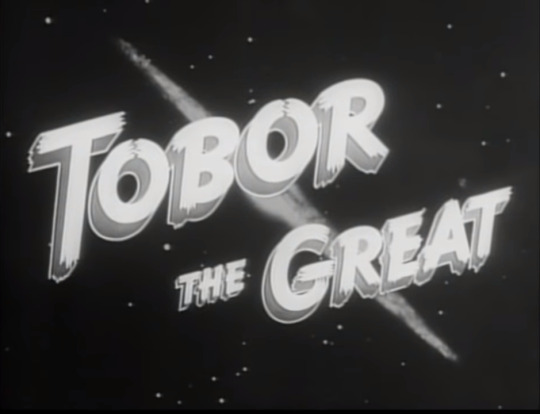
Tobor the Great
This was a movie YouTube thought I ought to watch. It’s so bad even Leonard Maltin didn’t like it.
Two scientists, Dr. Harrison and Dr. Nordstrom, are concerned about the effects of space travel on the human body, and so they attempt to convince the Civil Interplanetary Flight Commission (think NASA, but with funding) to use an alternative form of test pilot. No, sit down, dog- and monkey-lovers in the audience, I’m talking about a huge, unwieldy, unnecessarily humanoid robot! Obviously, foreign agents want to steal this machine and turn it into a huge, unwieldy weapon instead of a huge, unwieldy astronaut, but Nordstrom’s grandson Brian saves the day using his special telepathic link with Tobor!
The movie does not believe we’re smart enough to figure out why the robot’s name is Tobor. It spells it out for us, literally and on more than one occasion.
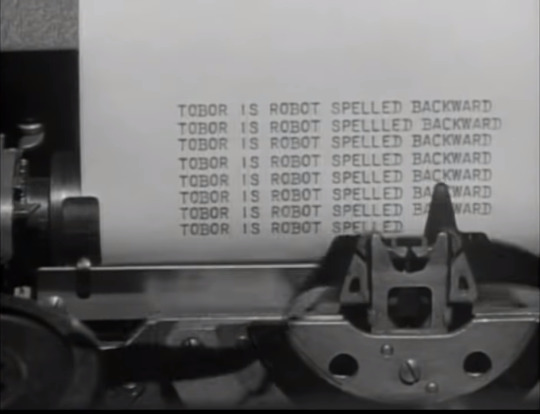
Tobor the Great is a children’s movie – the main character is eleven-year-old Brian, who is mostly addressed by his nickname, Gadget or Gadge. He’s established as an engineering genius in his own right, who gets to hang around in his grandfather’s lab and make friends with this cool robot. He’s what every white American boy in the 50’s was supposed to want to be. All of which makes it sort of weird that we don’t meet him until nearly fifteen minutes into the movie.
Consider some better children’s movies. In Coco, Miguel is the literal as well as the metaphorical narrator – we begin with his voice telling us the backstory. Lilo and Stitch gives us one title character almost immediately, and then brings in the second as quickly as it can to get us to the point where they meet. Of course, you don’t have to introduce the main character first in a movie, but if you’re going to put it off you have to do it skillfully. Star Wars takes its time getting around to Luke Skywalker, but it’s already given us somebody to follow in the form of C-3P0 and R2-D2, who make good audience proxies because 3P0 doesn’t know what’s going on any more than we do. Tobor the Great lets nearly a quarter of its running time go by before we finally meet Gadge, and even more before we get to Tobor himself, and that time is spent setting up what seems to be a rather different movie.
The opening does establish the need for Tobor, but it takes way too long about it. We start with narration and stock footage about the American space program, which is as deathly boring as it always is in these movies. Maybe it seemed more exciting in the fifties, when space rockets were the coolest thing around. Then we get into Dr. Harrison and his complaints about unsafe practices, which lead to his resignation and to him trying to dodge the press before meeting the likeminded Dr. Nordstrom.
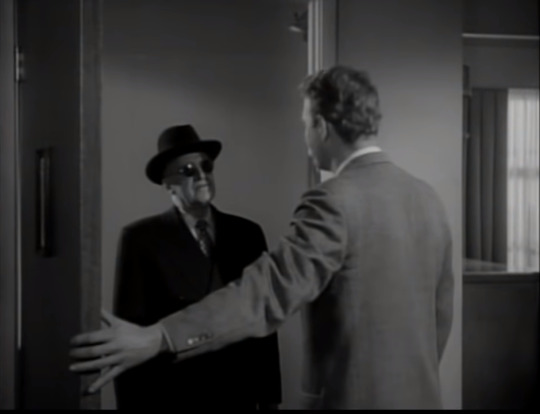
These seem like strange things to put in a children’s movie. I feel that a lot more time is spent justifying the need for a robotic astronaut than is really necessary, and the early close focus on Dr. Harrison makes it seem like he’s going to be our main character – but he fades into the background once we get to Dr. Nordstrom’s lab and at the end he’s not much more than a completely unnecessary love interest for Gadge’s widowed mother. In Star Wars the two droids stick around and participate in the plot for the whole movie – Dr. Harrison doesn’t. The politicking within the CIFC is not something children are likely to be interested in, nor is the nagging newspaper man, and all of these scenes are just guys in suits talking. Very little actually happens and none of it involves robots carrying off beautiful women like the poster shows us!
The annoying reporter is a particularly odd inclusion. His name is Mr. Gilligan, which Joel and the ‘bots would have found hilarious. I went into Tobor the Great totally blind, having never heard of it when the thumbnail appeared in my YouTube recommendations, but if I’d read a plot summary or something beforehand, maybe I wouldn’t have expected Gilligan to play a major role in the plot. As it was, I figured he was either a Soviet spy or would unintentionally pass information on to them – but he vanishes after the first press conference, and the question of whether he has the right to compromise national security in the name of selling newspapers is never dealt with. Instead the spies are a bunch of guys we’ve never seen before.
Once all this is over with, though, we do finally get to see Tobor strut his stuff. Nordstrom and Harrison work on programming him to do things like type reports to be sent back to Earth and dodge meteor showers (as all 50’s space rockets had to do), while Gadge sits and watches… and does very little else. You’d think this part of the movie would continue the thread of Gadge being the equal of the adult scientists, maybe overlapping with him and Tobor bonding, but there’s almost none of either. Why set up Gadge as a prodigy if you’re not going to make use of it? At the climax we expect Gadge to save the day by figuring something out, as he showed he could do earlier. Instead he just shuts his eyes and thinks really hard at Tobor, like Ichi trying to summon Gamera. It works, but it’s not as satisfying as it could have been. At the end the movie has neatly avoided almost all of its potential and anything that might have been cool to watch, and failed to give us anything it seemed to promise.
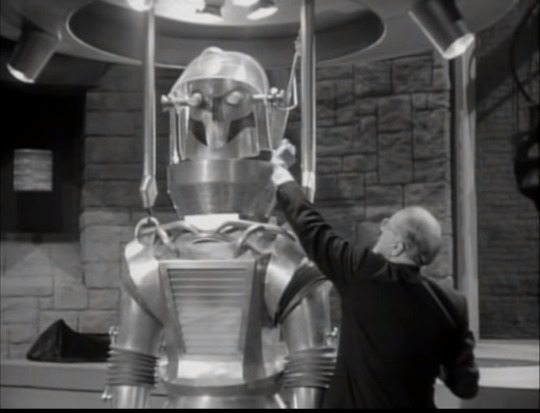
To make things even worse, Gadge is played by one of those insanely cloying 50’s child actors who say things like “oh, gosh!” and “gee whillikers!” I cannot imagine anybody actually talking like this. Actor Billy Chaplin sure makes it sound fake as hell. While Chaplin is a decent actor physically, everything he says sounds stilted and unnatural, like he’s reading it off notes while trying to project his voice to a full auditorium. The adult actors are much better, which just makes Chaplin look all the worse by comparison.
Tobor, on the other hand, is wonderful, in the ‘stupid cardboard movie robot’ way that makes Torg from Santa Claus Conquers the Martians and the delightfully awful robot of Devil Girl from Mars so much fun. It’s got lots of blinky lights and moving parts, and stamps around with a pretty convincing sense of weight. Unlike some movie robots it actually moves at a good clip when it wants to, perhaps helped by the fact that it has working knees. The movie makes the point that Tobor is a large and dangerous piece of kit at the same time as it’s able to be gentle and dexterous, which reinforces the idea that it would be frightening as a weapon.
My favourite part is when Tobor drives a car. I wonder if the guy in the costume could see anything. That must have been a hell of a day on set.
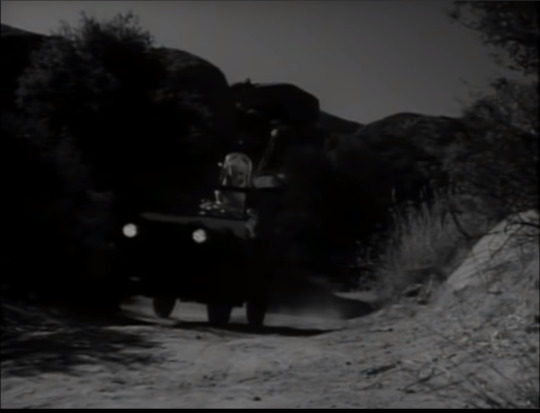
What you want me to get back to, though, is the bit where the robot is psychic. Yes, that’s actually the premise of this movie, a telepathic robot! I’m not sure how plausible that would have seemed in the 50’s, even in such an explicitly silly movie. Dr. Nordstrom doesn’t expect the reporters to believe in it without a demonstration, and yet the same decade also produced films like The She-Creature that present such ideas with an entirely straight, albeit incompetent, face. Psychic powers as hard-ish sci-fi seems to have gone out of style by the 90’s, and nowadays it sounds like something you’d see in the Weekly World News.
Man, I miss the hard copy Weekly World News. It was so nice to have that little isle of humour in the sea of garbage that was (and still is) the supermarket tabloids. Remember Hilary Clinton’s space-alien lover? Classic.
The function of telepathy in this story is not just to give Gadge a way to summon the robot after the spies break Nordstrom’s control mechanism. It is also a means whereby Tobor may acquire human traits and emotions. How to make a robot feel things is a perennial problem in science fiction… a lot of the time the mechanism is simply glossed over, as an artificial intelligence becomes more human by interacting with humans. Emotions are just chemicals in our brains, though, and the more we learn about how they work, the harder it gets to justify a machine feeling them. In Star Trek: the Next Generation Data and Lore have a special bit of hardware that must be installed to enable emotions, and really seem like they’re better off without it. In Saturn 3, Hector has a processor made of cloned brain cells that can produce their own chemistry, as well as a direct neural uplink to its programmer.
As such solutions go, I actually kind of like how Tobor the Great goes about it, even if the mechanism is silly. Rather than having emotions of its own, Tobor senses and mirrors those of the humans around it. When Gadge is panicking, worrying that Tobor is out of control, Tobor panics and goes around smashing things, thus making for a self-fulfilling prophecy. When Gadge thinks of Tobor as a hero, the robot comes to his rescue, carrying him to safety like a rescued princess, and responds to the anger and rage of the spies by turning these emotions back on them and beating them up. This is quite different from many ‘emotional machine’ stories, in that it doesn’t actually require Tobor to be in any way self-aware.
Unfortunately the movie is not very consistent about this. There’s a scene in which Tobor gets frustrated and breaks stuff after being put through too challenging a simulation, which does imply that the robot has an intelligence and emotional capacity of its own. This bit has a purpose, as it serves to make us worry that Tobor will be unable to tell the difference between friend and foe at the finale, but it just doesn’t fit with the way this machine is treated in the rest of the movie.
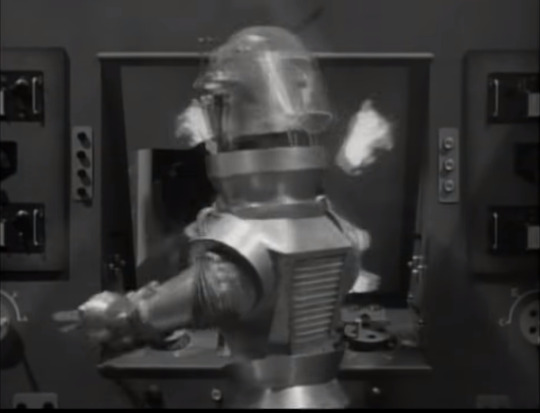
Like many others both from MST3K and from the Episodes that Never Were, Tobor the Great has a couple of good ideas at its core. It even predicted how much easier and safer it is to send robots into space than people, although those robots don’t look much like the lumbering humanoids of 50’s sci-fi. Sadly, the film is uneven, rushed, and poorly-acted, and nothing particularly fun or exciting happens in it. Various people over the years have seen its potential and Tobor has starred in a couple of comic books and an unproduced TV pilot, but these never went anywhere either.
24 notes
·
View notes
Photo

212: Godzilla vs Megalon
The Godzilla franchise has been around a long time, and has produced some classic films. The original Godzilla: King of the Monsters was a metaphorical meditation on the monstrous acts of World War II, and the recent Godzilla Resurgence is a critique of government impotence in the face of disaster. The average MSTie, however, is much more interested in the ridiculous than the sublime, and Godzilla has given us plenty of that, too. There's Godzilla vs Biollante, in which the monster's main foe is a mutant, sentient rose bush (seriously). There's Godzilla vs the Smog Monster, in which Godzilla learned to fly using his atomic breath as a rocket (again, seriously). There's Godzilla: Final Wars, which features fish aliens and the Japanese X-Men. And we cannot possibly forget Godzilla vs Megalon.
It's impossible to describe the plot of one of these movies briefly, not without leaving out a lot of what makes them so bizarre and entertaining, so this will take several paragraphs. An unnamed country (you can't call out the USA when they're the main foreign market for your movies) has set off one too many nuclear bomb tests, and pissed off the Seatopians. Like Atlantis, the continent of Seatopia sank into the ocean long ago, and the cling-wrapped inhabitants have lived peacefully on the bottom ever since. Now, however, they've decided they can no longer allow the surface people to threaten them with our atomic nonsense. They're sending Megalon, a giant cockroach with drills for arms, to lay waste to the Earth!
You probably think that sounds absurd. Well, hold on to your tightie-whities, I'm not half done.
Being a roach, Megalon is very tough but also extremely stupid, and the Seatopians don't trust him to find the world's major cities on his own. He needs a seeing-eye robot to show him the way. The people of Seatopia (there seem to be about nine of them) can't be bothered to build such a robot themselves, so they steal one from a couple of Japanese guys whose names I never caught. These appear to be a gay couple raising their adopted son in a self-consciously futuristic house, and their robot Jet Jaguar looks kind of like a mechanical Christmas elf designed by a six-year-old Power Rangers fan. Jet Jaguar can fly, however, and apparently has GPS, so it'll do the job just fine.
After a few shenaningans and one of the worst car chases ever committed to screen (the Rex Dart: Eskimo Spy! montage is actually better-edited and has more suspenseful music), our funkadelic heroes manage to steal their robot back. The Japanese military has sent their best footage from previous Godzilla movies against Megalon, but it doesn't do any more good than it did in the films they borrowed it from. Since everybody knows that the only way to destroy a giant rubber monster is with another giant rubber monster, the main characters send Jet Jaguar to Monster Island to get Godzilla.
Meanwhile, the now leaderless Megalon has begun just stomping on random things – Godzilla will never arrive in time to prevent more people from dying! Fortunately, in the midst of all these goings-on, Jet Jaguar has developed sentience. With Godzilla on the way, the robot reprograms itself to grow to gigantic size, thus making it a match for the monster. The Seatopians counter with a bonus monster of their own, borrowing Gigan from another previous installment in the series, and no less than four giants are now duking it out in the Japanese countryside while the humans look on in amazement!
Godzilla vs Megalon is kind of the Gamera vs Guiron of the Godzilla movies. It's terrible, and nothing in it makes the slightest bit of sense, and yet you can't help being entertained by it. Everything that happens is colourful and fun, even when cities are being destroyed, and some of the miniatures are actually reasonably convincing. The scene in which Megalon breaks a dam and threatens a truck where two of the heroes are being held prisoner actually looks pretty good. Like Gamera vs Guiron, the whole thing feels like a game being played by enthusiastic children trying to one-up one another, very much as Crow and Tom Servo do in their 'invent a monster' competition.
In the eyes of a six-year-old boy, living with your uncle who builds robots and his best friend the racecar driver would sound way cooler than having your Mom around telling you to pick up your toys (and a child of that age in 1973 would probably have no idea what the relationship between the two men actually is). Jet Jaguar, and his inventor's 'futuristic' home, look like things children would come up with, and the whole Easter Island aside (which never really comes to anything) could have been thrown in by a kid who is vaguely aware that the place figures in a lot of ancient aliens theories but doesn't know anything about the people who actually live there.
The monster fights also seem very childish, at times even cartoony: Jet Jaguar spins in place until he drills himself into the ground, for example, and a moment later Godzilla takes a running start and flies through the air to deliver a kick to Megalon's belly. Different Godzilla movies have different takes on how much personality the creatures have – Godzilla vs Megalon makes them quite anthropomorphic. None of the monsters actually talk, but it almost wouldn't feel out of place if they did. Their body language and interactions suggest very human thoughts and motivations. Megalon and Gigan gang up on Jet Jaguar like bullies picking on a smaller child in the schoolyard, and Godzilla comes to the robot's rescue like a best friend. Gigan threatens to rip Jet Jaguar's head off if Godzilla comes any closer, so Godzilla must figure out how to beat the other monster from a distance. These are not the actions of animals, but they are actions children might attribute to their imaginary creations.
Is the feeling of a child's game an intentional part of the movie, as I believe it was in Gamera vs Guiron? Probably – there's at least one thing in Godzilla vs Megalon that was very definitely designed by a child, and that's the robot, Jet Jaguar. Toho had held a contest for kids to come up with a new kaiju character, and Jet Jaguar was the winning entry. Originally, Godzilla wasn't even supposed to be in the film, but the studio chickened out and put him and Gigan in the mix when they got worried that nobody would go see Jet Jaguar vs Megalon. Godzilla vs Megalon would have been a child's adventure story with or without Godzilla, and so it makes sense that the rest of it should fit the childish aesthetic of Jet Jaguar.
Godzilla films are never very subtle about their messages, and this one is no exception: its intentional theme is the idea that nuclear weapons are dangerous and will ultimately destroy us if not handled properly – an idea it seems almost everybody can agree on and yet not one that makes for very good movies (remember Superman IV: the Quest for Peace?). Here, the anti-nuke message is muddled by several storytelling decisions, most notably the very inclusion of Godzilla himself.
In any incarnation, Godzilla always at least starts out as an embodiement of nuclear destruction. In Godzilla: King of the Monsters he was a metaphor for the bombing of Hiroshima and Nagasaki. In the stupid 1998 Americanization he was a nuclear test that got out of its makers' control. In Godzilla Resurgence he is implied to have arisen from the fallout of Fukushima. The idea of casting him in the role of guardian rather than destroyer thus becomes very strange when you think about it for a while, especially considering that he is a product of the imagination of only country ever actually nuked. I'm sure this is never what the writers had in mind, but it always seems as if movies in which Godzilla saves the Earth are telling us that bombing the fuck out of them will be an effective defense against alien invasions.
This gets even weirder when Godzilla's own innate symbolism is juxtaposed with the Seatopians. Seatopia is a country not unlike pre-Meiji Japan, in that it has placed itself in self-imposed isolation. These undersea people have been contentedly ignoring their neighbours for the past three million years until we started making an unavoidable nuisance of ourselves. They have a legitimate grievance and one that would find a great deal of sympathy among surface-dwellers, including our main characters – and yet they are never anything but the explicit villains of the film. What's more, their own superweapon, Megalon, is defeated by Godzilla, the living atom bomb! This is entirely at odds with the stated message of the film: it seems to say that actually, nuclear weapons are awesome, and will be used against anybody who tries to protest them! I don't think the writers thought that one through.
The Seatopians' own actions don't make a whole lot of sense, either. Japan does not build or test nuclear weapons – instead, the Japanese have embraced peaceful uses of nuclear power like almost no other nation on Earth. Why, then, should the Seatopians send Megalon to Japan? Were they aiming for the Soviet Union but got lost? Do they simply believe all the surface humans must go regardless of who has actually been setting off the fireworks? By all rights, this movie should have ended with the anti-nuclear surface-dwellers coming to an agreement with the Seatopians and working towards disarmament, but instead the idea of talking to these people and finding out what they want never occurs to anybody.
Needless to say, this is not a film that stands up to much analysis. It is much better enjoyed at a purely surface level, as eighty-one minutes of colourful, ridiculous fun for children – and on that level, I enjoy it very much.
#mst3k#reviews#godzilla vs megalon#70s#giant arthropod hours#magic voice recommends#tobor is robot spelled backwards
20 notes
·
View notes
